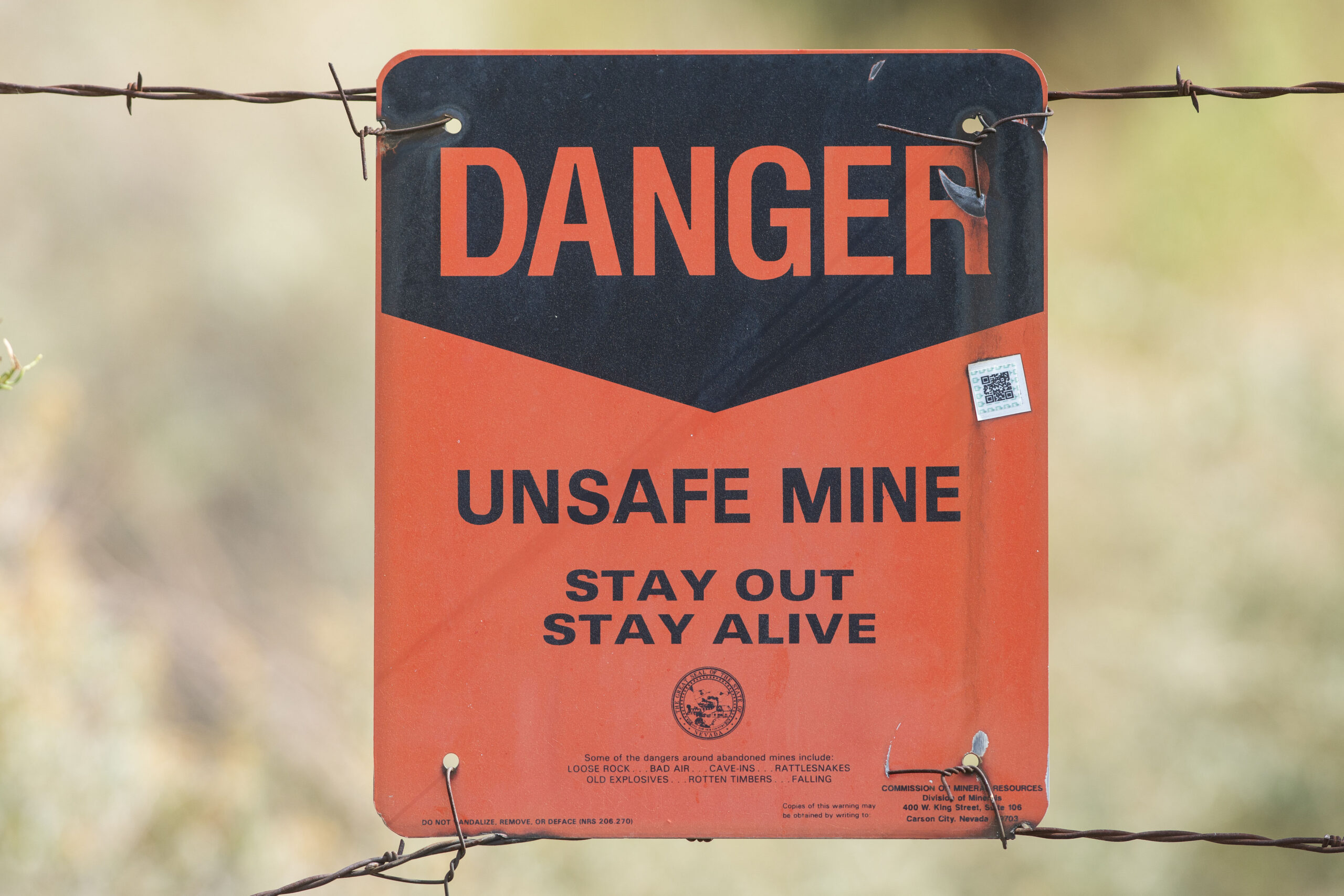Nevada has the most abandoned mines in the nation. Why is it taking so long to seal them?

Good morning, and welcome to the Indy Environment newsletter. I'm Amy Alonzo, the environment reporter for The Indy.
One of the best parts of living in Nevada is the access to wide open spaces. Whether it’s stargazing under inky black skies, hiking across trails with little other foot traffic or camping with nobody else nearby, the state offers an opportunity for solitude few other states can match.
But often those open spaces come with a little-known hazard — hundreds of thousands of abandoned mines pepper the state, from the hills around Virginia City to the shores of Lake Mead.
Nevada is tackling the problem, which has injured and killed dozens of people over the years, but it’s slow going without steady funding.
Around the new year, wishes for health and longevity abound. May your 2024 be safe — including steering clear of the state’s dangerous abandoned mines.
As always, we want to hear from readers. Let us know what you’re seeing on the ground and how policies are affecting you. Email tips to me at [email protected].
To get this newsletter in your inbox, subscribe here.

Rob Ghiglieri pauses his walk across a dusty hillside on the outskirts of Virginia City to look at a tangled web of footprints weaving in circles around the ruins of the abandoned Forman Shaft.
Once a massive, seven-story-tall structure, it boasted some of the deepest shafts in the West. Decades later, the shaft remained an accessible open pit plunging hundreds of feet into the ground.
The Forman Shaft has since been closed off — visitors can still drive to the site and wander around, but the entrance has been covered by a massive steel grate. Ghiglieri, administrator of the Nevada Division of Minerals, said he still worries when he sees so many footprints around old mine sites.
“Look at the amount of foot traffic,” he said. “There are people out here all the time.”
Nevada is home to the most documented abandoned mines in the nation — nearly 200,000. They encompass everything from small, hand-dug holes miles from the nearest town to large-scale operations near dense population centers with shafts that plunge down hundreds of feet.
Mine reclamation in Nevada was not enforced until the 1980s, when state lawmakers created the Nevada Division of Minerals’ Abandoned Mine Lands (AML) program to close off hazardous mines on public lands with no known owner.
The 100 years of unregulated exploration preceding the creation of the AML program left an estimated 50,000 abandoned mines across the state that are considered dangerous.
For generations, vacant mines big and small were largely open to anyone seeking to explore them — no matter how dangerous. Since 1961 — as far back as the state keeps records — there have been 19 reported human deaths and 24 injuries in Nevada’s mines. There have also been a dozen dogs reported injured or killed in mines.
In November, the division hit a landmark — after more than three decades of surveying, it reached the halfway mark in identifying the state’s dangerous mines.
At this rate, Ghiglieri said, the division will need another three or four decades to finish the job and inventory the remaining 25,000 hazardous mines.
And just because a mine has been identified as dangerous doesn’t mean anything has been done to make it safer. Sealing them takes manpower and money — two things the AML program is short on. The state does not directly fund the program, and billions of dollars authorized through the Bipartisan Infrastructure Act intended to help states with remediation have not materialized amid congressional gridlock.
Now, Ghiglieri and others working to close Nevada’s hazardous mines are watching as Congress debates the 2024 budget to see if this is the year that more funding is allocated to states.
“If this does get going and there is a dedicated funding source, we’d probably be the number one state for receiving revenue,” Ghiglieri said. “It would drastically increase our ability to get more work done.”
Enforcement of mine reclamation is relatively new
Modern mining started in Nevada in 1849 when a wagon train on its way to California discovered gold near what is now Dayton. Prospectors worked their way upstream, discovering massive gold and silver deposits — the Comstock Lode — in modern-day Virginia City.
As mining exploded in the state, it didn’t take long for unfruitful claims to be abandoned. According to the State Historic Preservation Office, the first mine abandoned in the state was in 1857 outside Las Vegas. Just four years later, the state saw its first mining-related death, when a man and his horse fell down a 100-foot shaft in Storey County.
Now, the division tracks the number of reported injuries and deaths in abandoned dangerous mines, and those accidents happen more frequently than Ghiglieri would like.
In 2020, a dog fell down a shaft in Pershing County and was rescued two days later. In 2013, a teenage boy suffered minor injuries after falling down a 60-foot-deep shaft in Lyon County.
The last reported mine-related death was in 2011, when a man fell 190 feet down a Pershing County shaft. Another man died three years earlier after falling 60 feet down a Lyon County winze, a small connector between different levels of a mine. In 2007, a California man died after his Jeep plummeted 500 feet to the bottom of the Loring Pit in Storey County.
In 1999, an 11-year-old Las Vegas girl died after falling in a mine while playing with her brother outside of Beatty, just three years after Storey County School District’s music teacher suffocated in the New Savage Mine in Virginia City while exploring it with a friend, who also died.
To curb the number of deaths and injuries in mines that are still open, the division has launched campaigns to educate the public about their danger. Billboard ads, YouTube videos and social media messaging have proved effective — there were no reported abandoned mine incidents in 2022.
A multibillion-dollar problem
Since the initial Comstock Lode rush, mining has continued to proliferate in Nevada as corporations unearth copper, lead, zinc, tungsten and lithium.
Now, regulations such as the Clean Water Act, National Environmental Policy Act and Federal Land Policy Management Act require permitting and bonding, but many of Nevada’s mines were dug before those protections were enacted.
“There was nothing stopping companies from just walking away,” Ghiglieri said.
Take Virginia City’s Forman Shaft, which reached an impressive 2,200 feet below the surface and was abandoned by the mid-1880s.
A fire in the early 1900s burned its structures, and the shaft eventually collapsed about 165 feet below the surface. But for more than 100 years, that 165-foot chasm was accessible to would-be explorers.
The state finally closed it off to the public in 2022, converting it to a bat habitat. The project’s size and its listing in the Virginia City Historic District, along with the cost of steel, led to it being the most expensive remediation project the division has done, Ghiglieri said, clocking in at about $450,000.
The program does not receive any state appropriations, and Ghiglieri estimates it needs about $400 million to finish closing off the state’s abandoned mines.
But the AML program relies on mining claim fees and surface disturbance fees for funding, and those mechanisms mean that each year’s budget varies — the program worked on a shoestring budget of $1.6 million in fiscal year 2022 and $1.43 million in 2021 — low numbers, but up from its 2020 budget of $885,000.
At the current rate of funding, it will be another century before Nevada finally completes remediation, he said.
“The question we always get is, ‘How many [dangerous abandoned mining] sites are there and how much will they cost to clean up?,’” Ghiglieri said. “We can’t answer either one of those accurately. We don’t know because we haven’t done the inventory because there’s no money.”
And Nevada’s $400 million is only a fraction of what’s needed nationwide.
According to a 2000 report from the Environmental Protection Agency, remediation of the nation’s half million abandoned mines spread across 32 states could cost upward of $35 billion.
Ghiglieri said he was hopeful when the federal government created the nation’s first hard rock abandoned mines program through the 2021 Bipartisan Infrastructure Act, authorizing $3 billion for the Department of Interior’s Abandoned Hardrock Mine Reclamation program over 10 years.
Thus far, only $5 million has been appropriated each year to the federal program.
Funding for fiscal year 2024 could increase slightly to $7 million, according to Moira Russell, hardrock AML program manager for the Department of Interior.
In 2022, federal lawmakers including Reps. Dina Titus (D-NV) and Steven Horsford (D-NV) requested at least $287 million for the program. In their letter, lawmakers cite newer federal estimates that pinpoint the nationwide cost of hardrock abandoned mine remediation at closer to $54 billion.
Federal lawmakers are also considering the Clean Energy Minerals Reform Act, introduced by Sen. Martin Heinrich (D-NM), which would charge companies fees toward reclamation of abandoned mines.
Ghiglieri wants more than words from lawmakers.
He wants the funding.

Here’s what else I’m watching this week:
My co-worker Carly Sauvageau unpacks what the construction of a housing development at Henderson’s Three Kids Mine looks like.
Electric vehicle and bike sales are growing — but repairing their batteries as they age remains a challenge, Grist reports.
Longtime Associated Press reporter Scott Sonner looks at the history of Burning Man, and if the event will continue to thrive in the decades to come.
Federal officials are forecasting less water than predicted flowing into Lake Powell — bad news for downstream Colorado River users, according to The Salt Lake Tribune.
A California doctor is pursuing an affordable treatment for poisonous snake bites. The L.A. Times offers an insightful read on a rarely reported-on problem.
